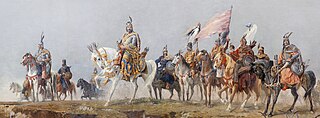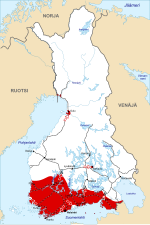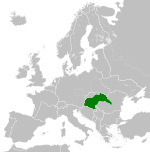
Finno-Ugric or Finno-Ugrian (Fenno-Ugrian), is a traditional grouping of all languages in the Uralic language family except the Samoyedic languages. Its formerly commonly accepted status as a subfamily of Uralic is based on criteria formulated in the 19th century and is criticized by some contemporary linguists such as Tapani Salminen and Ante Aikio as inaccurate and misleading. The three most-spoken Uralic languages, Hungarian, Finnish, and Estonian, are all included in Finno-Ugric, although linguistic roots common to both branches of the traditional Finno-Ugric language tree are distant.

Hungarian is a Uralic language spoken in Hungary and parts of several neighbouring countries. It is the official language of Hungary and one of the 24 official languages of the European Union. Outside Hungary, it is also spoken by communities of Hungarians in southern Slovakia, western Ukraine (Subcarpathia), central and western Romania (Transylvania), northern Serbia (Vojvodina), northern Croatia, northeastern Slovenia (Prekmurje), and eastern Austria.

The Uralic languages form a language family of 38 languages spoken by approximately 25 million people, predominantly in Northern Eurasia. The Uralic languages with the most native speakers are Hungarian, Finnish, and Estonian. Other significant languages with fewer speakers are Erzya, Moksha, Mari, Udmurt, Sami, Komi, and Vepsian, all of which are spoken in northern regions of Scandinavia and the Russian Federation.

Ural-Altaic, Uralo-Altaic or Uraltaic is a linguistic convergence zone and former language-family proposal uniting the Uralic and the Altaic languages. It is generally now agreed that even the Altaic languages do not share a common descent: the similarities among Turkic, Mongolic and Tungusic are better explained by diffusion and borrowing. The term continues to be used for the central Eurasian typological, grammatical and lexical convergence zone. Indeed, "Ural-Altaic" may be preferable to "Altaic" in this sense. For example, J. Janhunen states that "speaking of 'Altaic' instead of 'Ural-Altaic' is a misconception, for there are no areal or typological features that are specific to 'Altaic' without Uralic."

Finns or Finnish people are a Baltic Finnic ethnic group native to Finland.

The Finno-Samic languages are a hypothetical subgroup of the Uralic family, and are made up of 22 languages classified into either the Sami languages, which are spoken by the Sami people who inhabit the Sápmi region of northern Fennoscandia, or Finnic languages, which include the major languages Finnish and Estonian. The grouping is not universally recognized as valid.
Proto-Uralic is the reconstructed language ancestral to the Uralic language family. The language was originally spoken in a small area in about 7000–2000 BCE, and expanded to give differentiated protolanguages. New research has pushed the Proto-Uralic homeland east of the Ural Mountains and deep into Siberia.

The Finno-Permic (Fenno-Permic) or Finno-Permian (Fenno-Permian), or sometimes just Finnic (Fennic), are a proposed subdivision of the Uralic languages which comprises the Balto-Finnic languages, Sami languages, Mordvinic languages, Mari language, Permic languages and likely a number of extinct languages. In the traditional taxonomy of the Uralic languages, Finno-Permic is estimated to have split from Finno-Ugric around 3000–2500 BC, and branched into Permic languages and Finno-Volgaic languages around 2000 BC. Nowadays the validity of the group as a taxonomical entity is being questioned, and the interrelationships of its five branches are debated with little consensus.

Uralic–Yukaghir, also known as Uralo-Yukaghir, is a proposed language family composed of Uralic and Yukaghir.

Hungarian is a Uralic language of the Ugric group. It has been spoken in the region of modern-day Hungary since the Hungarian conquest of the Carpathian Basin in the late 9th century.
Elements of a Proto-Uralic religion can be recovered from reconstructions of the Proto-Uralic language.

Erik Alfred Torbjörn "Björn" Collinder was a Swedish linguist who was Professor of Finno-Ugric Languages at Uppsala University.

Hungarians, also known as Magyars, are a Finno-Ugric ethnic group. Native to Hungary and historical Hungarian lands who share a common culture, history, ancestry and language. The Hungarian language belongs to the Uralic language family. There are an estimated 15 million ethnic Hungarians and their descendants worldwide, of whom 9.3 million live in today's Hungary. About 2–3 million Hungarians live in areas that were part of the Kingdom of Hungary before the Treaty of Trianon in 1920 and are now parts of Hungary's seven neighbouring countries, Slovakia, Ukraine, Romania, Serbia, Croatia, Slovenia, and Austria. Significant groups of people with Hungarian ancestry live in various other parts of the world, most of them in the United States, Canada, Germany, France, the United Kingdom, Chile, Brazil, Australia and Argentina.

The Volga Finns are a historical group of indigenous peoples of Russia living in the vicinity of the Volga, who speak Uralic languages. Their modern representatives are the Mari people, the Erzya and the Moksha Mordvins, as well as speakers of the extinct Merya, Muromian and Meshchera languages. The Permians are sometimes also grouped as Volga Finns.
The Eskimo–Uralic hypothesis posits that the Uralic and Eskimo–Aleut language families belong to a common macrofamily. It is not generally accepted by linguists because the similarities can also be merely areal features, common to unrelated language families. In 1818, the Danish linguist Rasmus Rask grouped together the languages of Greenlandic and Finnish. The Eskimo–Uralic hypothesis was put forward by Knut Bergsland in 1959. It was expanded in 1998 by Michael Fortescue, an expert in Eskimo–Aleut and Chukotko-Kamchatkan, in his book Language Relations across Bering Strait where he proposed the Uralo-Siberian theory, including Yukaghir.

The Mishar Tatars form a subgroup of the Volga Tatars, indigenous to Mordovia, Tatarstan, Bashkortostan and Chuvashia in the Russian Federation. They also live in the Penza, Ulyanovsk, Orenburg, Nizhny Novgorod, Samara, Volgograd, and Saratov Oblasts of Russia and as an immigrant minority in Estonia, Latvia, and Finland. The Mishar Tatar dialect is one of the two Volga Tatar dialects.
Rogier Philip Charles Eduard Blokland is a Dutch linguist and Professor of Finno-Ugric languages at Uppsala University.
The Hungarian language is a member of the Uralic language family. The Hungarian Academy of Sciences and scientific support worldwide accept this conclusion. However, there is a history of other theories from before and after the Uralic connection was established, and some fringe theories continue to deny the connection.

The Finnic or Fennic peoples, sometimes simply called Finns, are the nations who speak languages traditionally classified in the Finno-Permic language family, and which originated in the region of the Volga River. The largest Finnic peoples by population are the Finns, the Estonians, the Mordvins (800,000), the Mari (570,000), the Udmurts (550,000), the Komis (330,000) and the Sami (100,000).
World Congress of Finno-Ugric Peoples is the representative forum of Finno-Ugric and Samoyedic people. The forum is not related to any government or political party. The goals of the forum is to "develop and protect national identity, cultures and languages of Finno-Ugric peoples, to promote cooperation between Finno-Ugric peoples, to discuss topical issues and to identify solutions, and to realise the right of Finno-Ugric peoples to self-determination in accordance with international norms and principles".





































